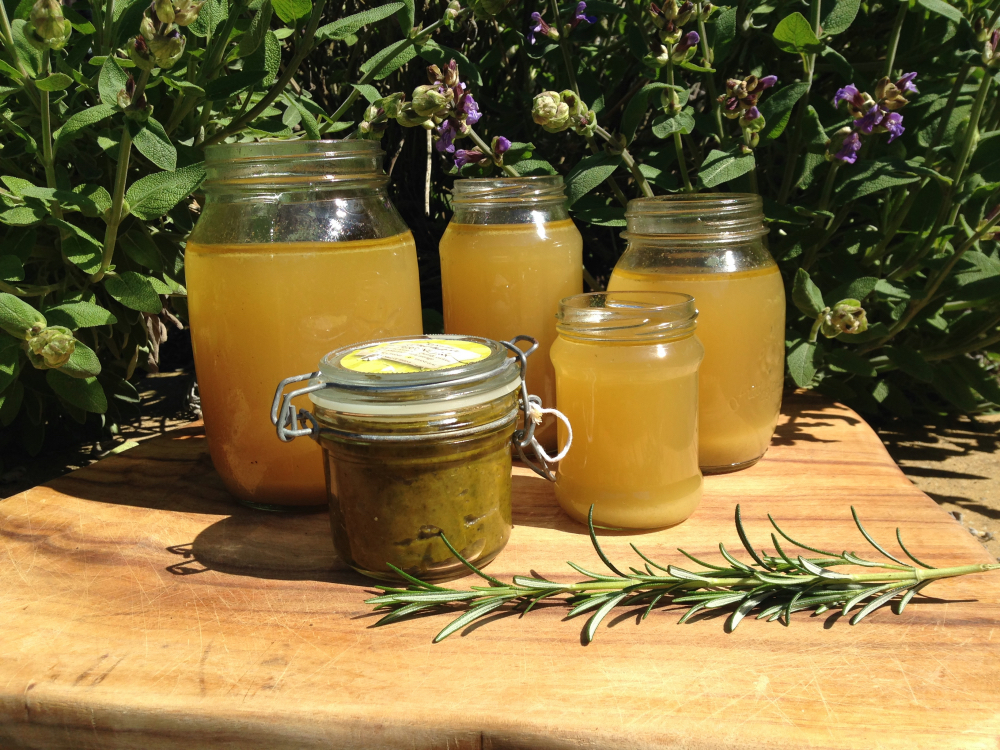Guest post by qualified Naturopath Rebecca Winkler.
I recently e-met the lovely Rebecca Winkler. Bec is a qualified Naturopath and GAPS practitioner with 10 years clinical experience, a busy mum to her beautiful sons aged 2 and 4 and owner of the online store – Natures Pantry. Bec lives with her family at Bells Beach on the surf coast in Victoria and runs her clinical practice in Jan Juc.
Bec freely admits that she is food obsessed and strongly believes in the power of food as medicine. She combines her passion for nutrition, diet and herbal medicine into her practice and helps many families navigate the tricky terrain of gut health, digestion, allergies and intolerances. Today Bec is sharing a few of her top tips along with three of her go-to recipes with us. Over to Bec!
It seems everywhere we turn at the moment, we are hearing about the gut in all of its glory! Bone broth is the new latte and gelatin and collagen a regular feature in our green smoothies. But do we really understand WHY the gut plays such an incredibly important role in the health of the rest of our mind and body?
As a Naturopath, I learnt very early on that the gut is integral to many facets of health including our immune system, digestive system and of course the absorption and assimilation of nutrients. In more recent times, with the help of amazing Doctors like Dr Natasha Campbell McBride, founder of the GAPS diet (whom I was lucky enough to train under earlier this year) and to amazing organisations like the Mindd Foundation, we are now making even more integral links to our gut and our mood and behaviour. We can fairly well safely say that the health and integrity of your gut is a huge determinant in the health of your entire body.
Here are my 5 top tips for improving and maintaining your gut health.
Get fermenting.
Sauerkraut, kefir, kombucha and kim chi are all wonderful little packages of fermented goodness! Although they are the new kids on the block so to speak, they have actually been traditionally consumed in many European and Asian cultures for centuries. Fermented foods and beverages provide incredible amounts of good bacteria for your gut. Unlike manufactured probiotics, good bacteria that is produced during the fermenting process actually colonise to the gut wall, bunking down for the long haul. Whilst probiotics certainly have a place for acute recolonisation after infections and antibiotics, they don’t adhere to your gut wall as well and thus, are generally more effective whilst they are being taken.
Make your own or buy from a good, reputable source and incorporate some fermented foods into your daily diet. Just a little note however, start slow, say perhaps a teaspoon of kraut and just 20-30ml of kombucha or kefir to start with. It’s powerful stuff!
Keep an eye out for local fermenting workshops and seminars too. It will save you lots of $$!
Avoid or reduce foods that irritate and inflame the gut.
When the gut lining is damaged, whether from factors such as infections (parasitic, bacterial, gastro, food poisoning), diets high in processed foods and low in essential nutrients and fats and / or environmental toxins such as pesticides, chemicals and pharmaceuticals, oh, and genetics (!) it becomes incredibly sensitive, irritated and inflamed.
Due to damage to the micro villi that secrete enzymes to break down certain proteins like lactase responsible for breaking down lactose in dairy products, the gut become less tolerant to many foods. The main ones are gluten, dairy, legumes (due to their tough exterior) as well as sugar, caffeine and alcohol. Many people also have difficulty digesting other grains such as rice and quinoa. Because food is not digested as thoroughly as it should be, partially digested food makes its way into the blood stream through the leaky gut walls, triggering an abnormal immune response. This can lead to heightened allergies, intolerances, asthma, eczema and auto immune responses.
From my experience I believe that the best diet to consume to support your gut is one low or void of grains (temporarily until the gut heals), and high in fats, protein, whole foods, nuts seeds and fresh, organic fruit and vegetables.
Bone Broth.
Once a upon a time, only our nannas made bone broth and rich soups made with bones and carcasses. But as we are now beginning to see the generations that came before us were actually on to something. Bone broth is simply a rich stock type of liquid made using animal bones (chicken, pork, beef or lamb) and simmered for 24 hours over a low heat with a few vegetables and some vinegar. This process and the addition of the vinegar causes all of the gelatin, collagen, minerals and amino acids to leach from the bones, creating an incredibly nourishing, healing food.
Gelatin and collagen are essentially the building blocks for repair to tissue, bone and cartilage. Perfect for mending the broken walls of the mucous membrane lining our entire digestive tract. The addition of bone broth is an integral part of initiating gut healing and the cornerstone of the GAPS diet. You can drink it on its own or use is as a base in soups, slow cooked stews and in sauces and curries. If you have not made broth before you can check out my simple recipe below.
Consume a diet high in good fats.
Now this is a somewhat controversial one. For decades we have been taught that fat in all forms is best avoided. In the 1980’s we started consuming low fat diets which inadvertently were high in sugar. But sugar was fine, because it didn’t contain fat, right? Wrong! We now know that refined sugars and carbohydrates convert to fats and triglycerides in the blood and liver when consumed in excess. Which is far more damaging to our body and hearts than fat ever was.
An irritated gut also struggles to absorb fats and hence many become low in fat soluble vitamins. We are now seeing endemic proportions of vitamin D deficiency in Australia.
I strongly suggest, where well tolerated, including fatty fish, cold pressed oils, coconut oil, organic nuts and seeds, eggs and free range or organic poultry and meat into your diet and throwing away the margarine.
Get your gut and related symptoms sorted out.
Whilst there is a plethora of wonderful information available for navigating your gut journey, nothing compares to the guidance and experience of the right practitioner. There is never a one size fits all approach. Find a great naturopath or nutritionist in your area and seek their advice. Digestive symptoms, allergies, auto immunity and intolerances are nothing to sneeze at and really require some expert management to find the best plan for you and your body.
Today I am sharing with you a few of my families favourite gut healing recipes. I hope you enjoy them too.
We eat a lot of roast chicken. We purchase organic or free range chickens and simply roast them whole in the oven. I usually stuff the chicken with fresh herbs from my garden, half a lemon and some butter and rub the skin with either organic butter, ghee or olive oil and pink himalayan salt.
Once I have removed the cooked chicken, I pop the carcass and bones into a bag in the freezer, once I have 3-4 carcass’, I make a big batch of broth as outlined below.
Alternatively you can use beef, lamb or pork bones. It is worth checking with your local butchers and farmers markets as they are often happy to sell bones very cheaply.
Chicken Bone Broth
- 3-4 chicken carcasses (1-2 if you are using a slow cooker)
- Enough water to just cover the bones
- 2 carrots
- 3 stalks of celery
- 1 onion
- 2-3 cloves of garlic
- 50ml apple cider vinegar
- whatever fresh herbs you have floating around. I use rosemary, sage and parsley.
- 1 tablespoon good quality salt such as himalayan or murray river flakes
- Place everything in a large stock pot or slow cooker and add enough water to cover. (I recommend using the stove only if you have an electric stove top. The naked flame of a gas cook top can be a hazard).
- Place on the lowest heat with the lid on for 24 hours and leave untouched.
- Once the 24 hours are up strain the broth through a large colander and then through a fine sieve to ensure all solids are removed.
note – You can store the broth in the fridge for 5-7 days or in the freezer in jars/containers for up to 3 months. It doesn’t make it to the freezer in my house. Use it wherever you would use liquid stock, soups, curries, slow cooked meals or on its own.
As broth has a low salt content you will have to add stock in some form if you wish to add a salty flavour to your dish. I make a simple vegetable stock concentrate once every few months and keep it in the fridge in a jar. Here is the stock recipe I use, some of you may recognise it;)
Vegetable Stock Concentrate
- 2 carrots
- 2 stalks of celery
- 1 onion
- 1 tomato
- 1 large zucchini
- 1 bunch of fresh parsley
- a few sprigs of whatever fresh herbs you may have, I quite often add in basil, rosemary and sage
- 2 cloves of garlic
- 150g of pink himalayan salt
- 20g of olive oil
- Place all vegetables and herbs into a blender until they resemble a grated consistency.
- Heat the oil in a saucepan, add the vegetable mix and cook on a medium heat, moving regularly with a wooden spoon, for approximately 10 minutes.
- Place warmed mixture back into blender with 150g salt and blitz until you have a fine paste.
- Place your paste in a air tight glass jar in the fridge and use as required. Generally 1 tablespoon of paste per 500ml water to make vegetable stock. This will keep for months in the fridge and can be added to soups, stews, sauces and curries.
Lastly, my ‘go-to’ meal for gut health, convenience and most importantly taste!
This is one of those meals that pleases everyone in my house, which can be rare. My 4 and 2 year old boys love it and my husband and I would have this at least once a week in Winter.
Chicken Bone Broth Soup
- 2 zucchinis, grated
- 2 carrots, grated
- ¼ celery, diced
- 1 large onion, diced
- 2 cloves of garlic, crushed
- meat from 1 roast chook, alternatively you may add a cooked chicken breast
- a bunch of parsley, roughly chopped
- 2 packets of sweet potato noodles (available in most supermarkets in the Asian section). Cook separately in boiling water and add at the end to avoid making your soup starchy.
- 2 litres of chicken bone broth (approximately, I’m not a big measurer when I cook. The recipe is outlined above).
- 3 tablespoons of organic butter, ghee or oil of your choice
- 3 tablespoons of vegetable stock concentrate (recipe above)
- Fry off all vegies, onion and garlic in your butter/oil until soft.
- Add our broth and stock paste and simmer for around half an hour.
- Add your broken up roast chicken and cooked sweet potato noodles and simmer for a further 15 minutes.
- Take the soup off the heat, add parsley and serve in a big, deep bowl! Season with salt or pepper.

I wish you all the best on your journey. You can read more about health and healing on my website and facebook page or find me on Instagram @treeoflifenaturalhealth.





 Based on 13 Review(s)
Based on 13 Review(s)